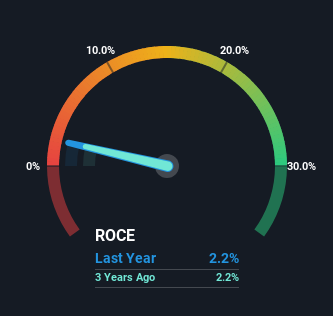- China
- /
- Semiconductors
- /
- SHSE:600360
Returns On Capital Signal Tricky Times Ahead For Jilin Sino-Microelectronics (SHSE:600360)
Finding a business that has the potential to grow substantially is not easy, but it is possible if we look at a few key financial metrics. Typically, we'll want to notice a trend of growing return on capital employed (ROCE) and alongside that, an expanding base of capital employed. This shows us that it's a compounding machine, able to continually reinvest its earnings back into the business and generate higher returns. Although, when we looked at Jilin Sino-Microelectronics (SHSE:600360), it didn't seem to tick all of these boxes.
Return On Capital Employed (ROCE): What Is It?
For those who don't know, ROCE is a measure of a company's yearly pre-tax profit (its return), relative to the capital employed in the business. To calculate this metric for Jilin Sino-Microelectronics, this is the formula:
Return on Capital Employed = Earnings Before Interest and Tax (EBIT) ÷ (Total Assets - Current Liabilities)
0.022 = CN¥110m ÷ (CN¥6.9b - CN¥1.9b) (Based on the trailing twelve months to September 2023).
So, Jilin Sino-Microelectronics has an ROCE of 2.2%. In absolute terms, that's a low return and it also under-performs the Semiconductor industry average of 5.6%.
Check out our latest analysis for Jilin Sino-Microelectronics

Historical performance is a great place to start when researching a stock so above you can see the gauge for Jilin Sino-Microelectronics' ROCE against it's prior returns. If you want to delve into the historical earnings , check out these free graphs detailing revenue and cash flow performance of Jilin Sino-Microelectronics.
What Can We Tell From Jilin Sino-Microelectronics' ROCE Trend?
When we looked at the ROCE trend at Jilin Sino-Microelectronics, we didn't gain much confidence. To be more specific, ROCE has fallen from 6.1% over the last five years. Given the business is employing more capital while revenue has slipped, this is a bit concerning. This could mean that the business is losing its competitive advantage or market share, because while more money is being put into ventures, it's actually producing a lower return - "less bang for their buck" per se.
On a side note, Jilin Sino-Microelectronics has done well to pay down its current liabilities to 28% of total assets. That could partly explain why the ROCE has dropped. Effectively this means their suppliers or short-term creditors are funding less of the business, which reduces some elements of risk. Since the business is basically funding more of its operations with it's own money, you could argue this has made the business less efficient at generating ROCE.
Our Take On Jilin Sino-Microelectronics' ROCE
In summary, we're somewhat concerned by Jilin Sino-Microelectronics' diminishing returns on increasing amounts of capital. And, the stock has remained flat over the last five years, so investors don't seem too impressed either. With underlying trends that aren't great in these areas, we'd consider looking elsewhere.
If you'd like to know more about Jilin Sino-Microelectronics, we've spotted 4 warning signs, and 2 of them are a bit unpleasant.
While Jilin Sino-Microelectronics isn't earning the highest return, check out this free list of companies that are earning high returns on equity with solid balance sheets.
New: Manage All Your Stock Portfolios in One Place
We've created the ultimate portfolio companion for stock investors, and it's free.
• Connect an unlimited number of Portfolios and see your total in one currency
• Be alerted to new Warning Signs or Risks via email or mobile
• Track the Fair Value of your stocks
Have feedback on this article? Concerned about the content? Get in touch with us directly. Alternatively, email editorial-team (at) simplywallst.com.
This article by Simply Wall St is general in nature. We provide commentary based on historical data and analyst forecasts only using an unbiased methodology and our articles are not intended to be financial advice. It does not constitute a recommendation to buy or sell any stock, and does not take account of your objectives, or your financial situation. We aim to bring you long-term focused analysis driven by fundamental data. Note that our analysis may not factor in the latest price-sensitive company announcements or qualitative material. Simply Wall St has no position in any stocks mentioned.
About SHSE:600360
Jilin Sino-Microelectronics
Designs, develops, and markets semiconductor devices in China and internationally.
Solid track record with mediocre balance sheet.
Market Insights
Community Narratives




